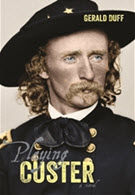| News |
| Monday, 03 August 2015 00:00 |
|
Playing Custer Reviewed in the Anniston Star Before the book begins, Duff reminds us that history is fiction, never truth, and he has found a compelling way to argue that point. It's all part of his novel's structure, which moves seamlessly among the actual "actors" from the actual "drama" — Crazy Horse and Gall and Sitting Bull, Myles Keogh and Marcus Reno and George Armstrong Custer — and the fictional Last Stand Reenactors on the 125th anniversary of the climactic Last Stand on the Little Bighorn. Waymon Needler and his buddy Mirabeau Lamar Sylestine travel to the reenactment of 2001. Having once played "Patrick Bruce, the raw recruit lately from Ireland," Waymon is this year playing Maj. Marcus Reno, who during the Last Stand "abandoned his command in combat and ran for his life" and "called his abject flight a charge, hoping to forestall criticism of his cowardice even as he was displaying it." Waymon's role in this year's reenactment is an ironic comment on his life in general. He isn't at all like Mirabeau, who is already claiming convenient Indian ancestry and who can, with little effort, transform himself into Eagle Beak. Waymon is stuck being, as he tells us, "Waymon Needler, teacher of home economics in the public high school of Annette, Texas, no matter what strange garb I donned or makeup and fake beard I put on my face." That discontent is movingly clarified by Mirabeau, clarified for both white man and red man, as he watches Waymon's hasty transformation into Custer after a last-minute change of reenactors midway through the novel: "to the white man, the real may become a dream and thus vanish. To us, those who lost this land that we didn't even know we had until it was gone, the dream becomes real." Then Mirabeau, too, is given a shot at transformation as he transmutes from Eagle Beak into Crazy Horse. And the last stand is reenacted once more. But as Gerald Duff recounts the actual Last Stand and the "latest" last stand, his book takes an interesting turn. "Playing Custer" becomes not just history — history is, after all, completed. The participants in the original Last Stand, the only one really, have already made that particular history. "Playing Custer" then becomes about the importance of making our own history by moving into what we are, rather than by reenacting what we think others were. "Playing Custer" is at times acutely horrifying: Duff's re-creation of the actual Last Stand from many viewpoints can indeed be disturbing. The book, at the same time, can be deeply moving, especially as Libbie, Custer's widow, prepares to visit the wives who were widowed at the same time she was. It can also be wildly funny and unexpectedly affecting, as Waymon and Mirabeau leave the reenactment for other lives, having discovered that, according to Duff: "It all depends on how you're turned and the final direction you decide to head." To read the review online at The Anniston Star, click here. |

